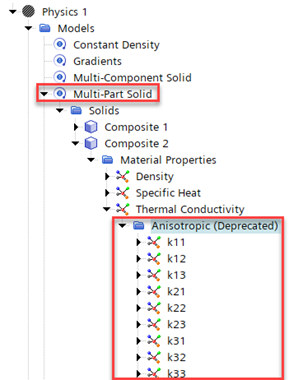Anisotropic Thermal Conductivity for Multi-Part and Multi-Layer Solid
Problem Statement
A customer modeling anisotropic thermal conductivity in a composite panel skin layer using STAR-CCM+ multiphysics CFD code encountered a deprecated or legacy functionality when using a Multi-Part Solid or Multi-Layer Solid, as shown in the below figures, respectively.
The following warning message appears:

Warning: Anisotropic (Depricated/Legacy) material property method (used in Composite 2 for Thermal Conductivity) has been deprecated starting in Simcenter STAR-CCM+ 2210 and is planned to be removed in 2306. Please contact your Simcenter customer support representative for further information.
How do you model solid anisotropic thermal conductivity in STAR-CCM+ using a Multi-Part Solid or Multi-Layer Solid?
Multi-Part Solid
The Anisotropic (Deprecated) physics allows a full matrix of 2x2 = 4 values in 2D & 3x3 = 9 values in 3D, and it has been argued that the full matrix does not conform to any real material and should instead be replaced by a symmetric specification method (3 values in 2D & 6 values in 3D), as shown in the below figure.

This is why a new Anisotropic (6 components) material
property specification method has been introduced for Thermal Conductivity, as
shown in the below figure.
Multi-Layer Solid
Anisotropic (6 component) will be available with Multi-Layer solid model in future versions. As a replacement, a new "Region Scalar Profile" material property specification method has been introduced for Thermal Conductivity material property which allows you to specify a scalar profile at Region > Physics Values level. You can specify thermal conductivity using different methods including Field Function, Table (x,y,z), User Code, etc. The same material property specification method is available for Multi-Part Solid.
V2302 Documentation and Corrections
- Simulating Physics > Materials > Modeling Multi-Component Solids > Multi-Part Solid Model Reference
- If any material in the simulation has anisotropic thermal conductivity, create a dedicated physics continuum for that material. The Multi-Part Solid model does not currently support materials that require the Anisotropic method for Thermal Conductivity.
- The previous bullet listed in the documentation for v2302 has not been updated to reflect the actual functionality as confirmed with the development team. You may specify Anisotropic thermal conductivity for each part under the same Physics or Regions.
- Simulating Physics > Materials > Modeling Multi-Component Solids > Multi-Layer Solid Model Reference
- Effective Anisotropic Thermal Conductivity tensor:
- This formula related to the Anisotropic (Deprecated) method is expected to be removed from User Guide.
Related Articles
Simulating Surface-to-Surface thermal radiation between objects in a vacuum environment
Problem This article describes how to set up Surface-to-Surface (S2S) radiation energy exchange between objects in a vacuum environment using STAR-CCM+ multi-physics CFD software. Specifically, a manufactured part (Hot_Box) is placed on top of a ...Pre-Processing Workflow for a Fluid Channel with Solid Blockage in STAR-CCM+
Overview This tutorial walks users through setting up a CFD simulation of a simple fluid channel containing a solid blockage using Simcenter STAR-CCM+. Building on the geometry created in Build a Flow Channel with a Solid Blockage in STAR-CCM+ ...Build a Flow Channel with a Solid Blockage in STAR-CCM+ 3D-CAD
Overview This tutorial explains how to create a simple flow domain with a solid blockage using Simcenter STAR-CCM+ 3D-CAD parametric modeler. Domain Construct a basic flow channel that will define the domain. Right-click Geometry > 3D-CAD Models and ...What's New in STAR-CCM+ v2302?
What's in this webinar? SDA Software Engineer Ted Blowe presents this webinar on What's New In STAR-CCM+ v2302. During this webinar you will learn about some of the exciting new enhancements in the latest version of STAR-CCM+, including the following ...What's New in Simcenter STAR CCM+ v2510
What's in this Webinar? Join us for an in-depth look at the latest enhancements in Simcenter STAR-CCM+ v2510. Discover how these new capabilities improve simulation accuracy, speed, and usability—helping you deliver better designs faster. Topics ...